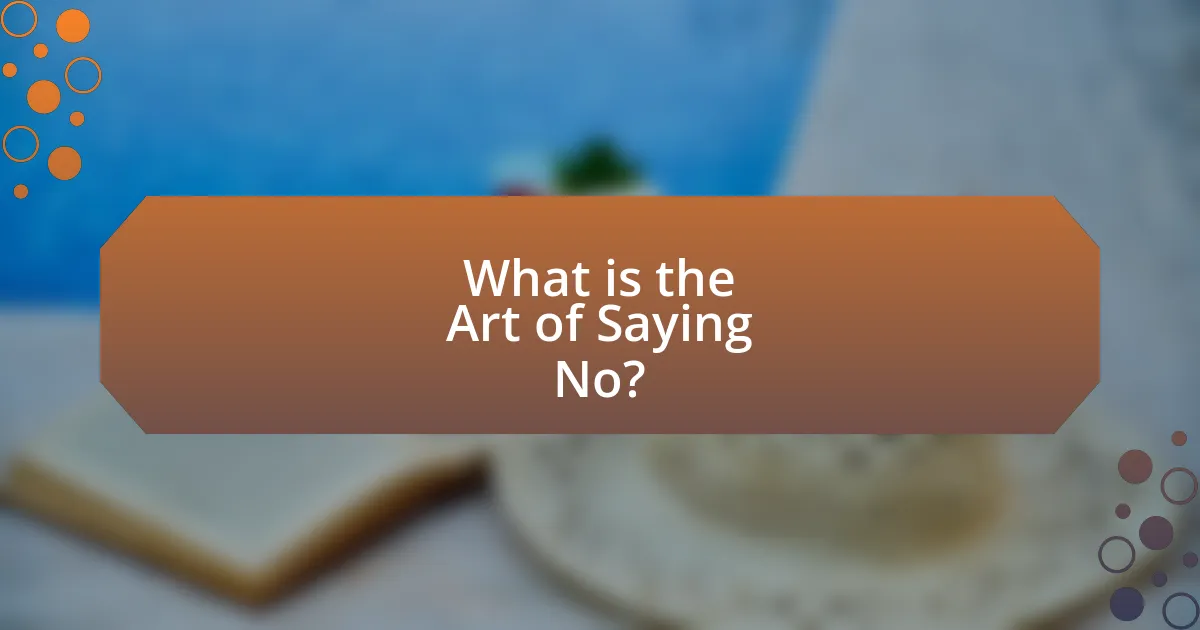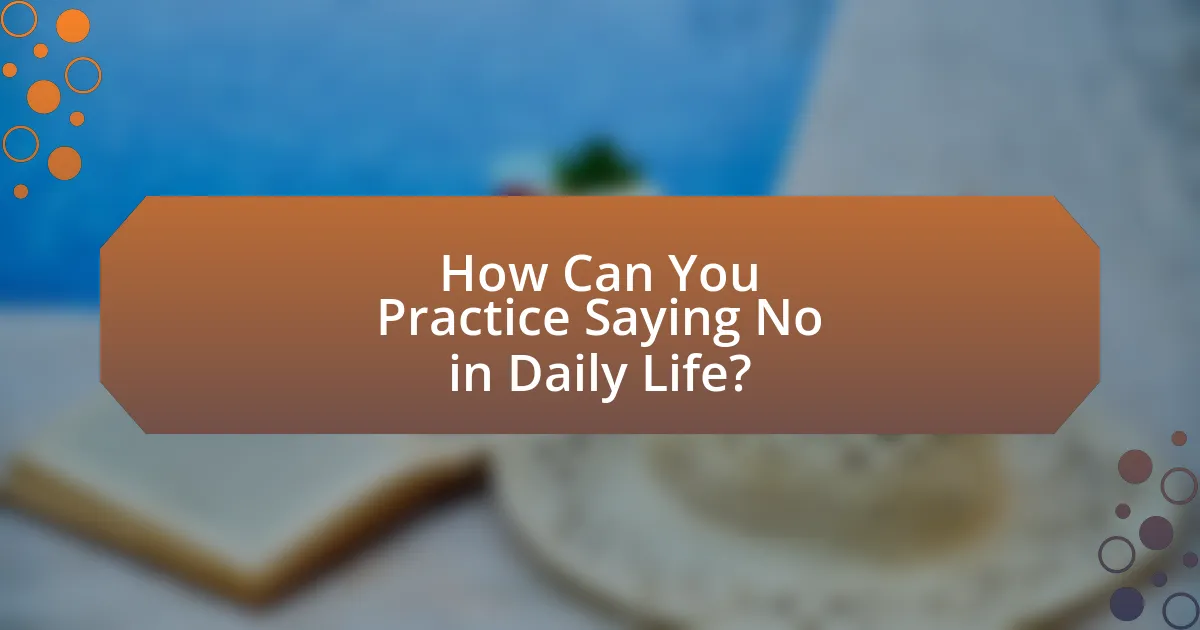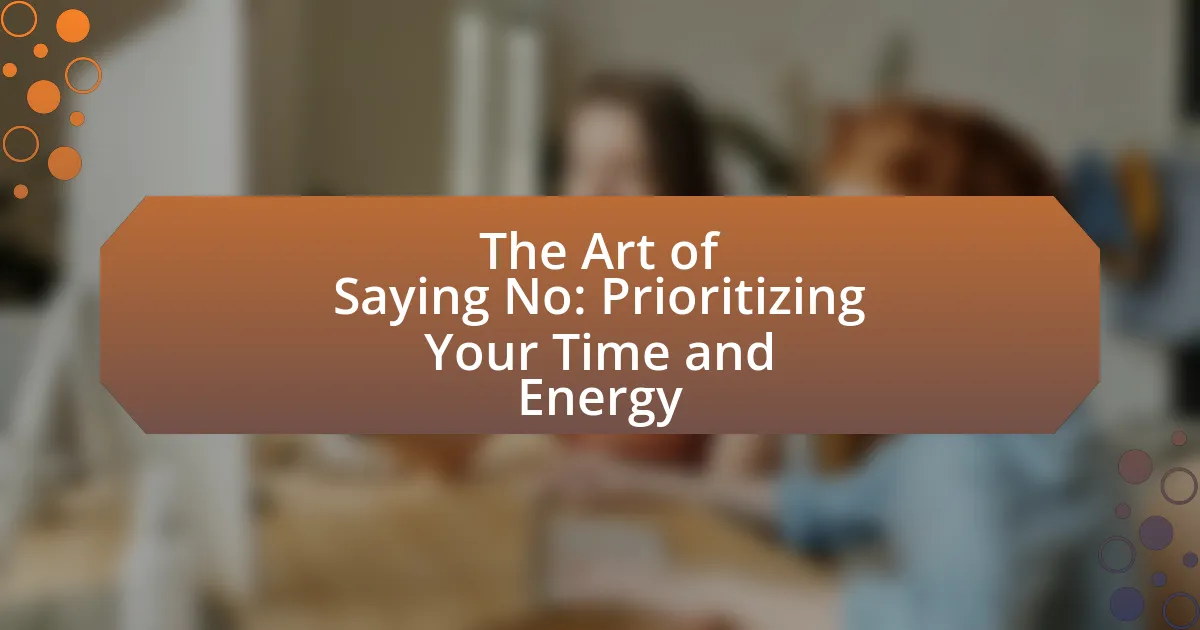The main entity of the article is “The Art of Saying No,” which emphasizes the importance of respectfully declining requests to prioritize personal time and energy. The article outlines how saying no is crucial for effective time management, personal boundaries, and stress reduction, ultimately enhancing productivity and well-being. It discusses strategies for saying no assertively, the impact of body language, and techniques to overcome guilt associated with refusal. Additionally, the article highlights the long-term benefits of mastering this skill, including improved mental health, stronger relationships, and personal growth.

What is the Art of Saying No?
The Art of Saying No is the skill of respectfully declining requests or invitations to prioritize one’s own time and energy. This practice enables individuals to maintain boundaries, reduce stress, and focus on their personal and professional goals. Research indicates that people who effectively say no experience lower levels of anxiety and higher satisfaction in their commitments, as they are not overextending themselves. By mastering this art, individuals can enhance their productivity and well-being.
Why is Saying No Important for Time Management?
Saying no is important for time management because it allows individuals to prioritize their commitments and focus on tasks that align with their goals. By declining requests that do not contribute to personal or professional objectives, individuals can allocate their time and energy more effectively. Research indicates that people who set boundaries by saying no experience reduced stress and increased productivity, as they can concentrate on high-priority tasks rather than spreading themselves too thin. This practice ultimately leads to better time management and improved overall performance.
How does Saying No Impact Personal Boundaries?
Saying no strengthens personal boundaries by clearly communicating individual limits and preferences. When a person asserts their right to decline requests, it reinforces their autonomy and self-respect, which are essential components of healthy boundaries. Research indicates that individuals who practice saying no experience reduced stress and increased satisfaction in their personal and professional lives, as they prioritize their time and energy effectively. This practice not only protects one’s mental and emotional well-being but also fosters respect from others, as it establishes a clear understanding of what is acceptable.
What Role Does Saying No Play in Reducing Stress?
Saying no plays a crucial role in reducing stress by allowing individuals to set boundaries and prioritize their own needs. When people decline requests or obligations that do not align with their priorities, they prevent overwhelm and maintain control over their time and energy. Research indicates that individuals who practice assertiveness, including saying no, report lower levels of stress and improved mental well-being. A study published in the Journal of Health Psychology found that assertive communication, which includes the ability to say no, is linked to reduced anxiety and greater life satisfaction. Thus, saying no is an essential skill for managing stress effectively.
How Can Saying No Enhance Productivity?
Saying no enhances productivity by allowing individuals to focus on their most important tasks and commitments. When people decline requests that do not align with their priorities, they free up time and mental energy, enabling them to concentrate on high-impact activities. Research indicates that individuals who practice saying no are more likely to achieve their goals and maintain a balanced workload, as they avoid overcommitment and burnout. For instance, a study published in the Journal of Applied Psychology found that employees who set clear boundaries by saying no reported higher job satisfaction and productivity levels.
What Are the Consequences of Not Saying No?
Not saying no can lead to overcommitment and burnout. When individuals fail to set boundaries, they often take on more responsibilities than they can handle, resulting in increased stress and decreased productivity. Research indicates that chronic stress from overcommitment can lead to mental health issues such as anxiety and depression. Additionally, not saying no can strain personal relationships, as unmet obligations may lead to resentment from others. Therefore, the consequences of not saying no include diminished well-being, reduced effectiveness in tasks, and potential harm to interpersonal connections.
How Does Saying No Help in Prioritizing Tasks?
Saying no helps in prioritizing tasks by allowing individuals to focus on their most important responsibilities and commitments. When people decline additional tasks or requests, they create space in their schedules for high-priority activities that align with their goals. Research indicates that individuals who practice saying no are more likely to manage their time effectively, as they avoid overcommitting and experiencing burnout. This selective approach to task management enhances productivity and ensures that energy is directed toward meaningful work, ultimately leading to better outcomes.

What Strategies Can Help You Say No Effectively?
To say no effectively, establish clear boundaries and communicate them assertively. This involves being direct and honest about your limitations, which helps prevent misunderstandings. Research indicates that individuals who practice assertiveness are more likely to maintain their boundaries and reduce feelings of guilt associated with saying no. For instance, a study published in the Journal of Personality and Social Psychology found that assertive communication leads to better emotional well-being and less stress. Additionally, using phrases like “I appreciate the offer, but I cannot commit to this right now” allows for a polite yet firm refusal, reinforcing your decision without unnecessary elaboration.
How Can You Communicate Your No with Confidence?
To communicate your “no” with confidence, assertiveness is key. Assertiveness involves expressing your thoughts and feelings openly while respecting others. Research indicates that assertive communication can lead to better interpersonal relationships and reduced anxiety (Rosenberg, Marshall. “Nonviolent Communication: A Language of Life”). Use clear, direct language, maintain eye contact, and adopt a calm tone to convey your message effectively. This approach not only reinforces your decision but also demonstrates respect for both your own boundaries and the other person’s feelings.
What Phrases Can You Use to Say No Politely?
To say no politely, you can use phrases such as “I appreciate the offer, but I must decline,” “Thank you for thinking of me, but I can’t commit at this time,” and “I wish I could help, but my schedule is full.” These phrases convey respect and gratitude while clearly communicating your inability to accept the request. Using polite language helps maintain relationships and shows consideration for the other person’s feelings.
How Can Body Language Support Your Decision to Say No?
Body language can significantly support your decision to say no by conveying assertiveness and clarity without the need for verbal confirmation. Non-verbal cues such as maintaining eye contact, adopting an open posture, and using firm gestures reinforce your message and signal confidence. Research indicates that 93% of communication is non-verbal, highlighting the importance of body language in expressing your intentions effectively. For instance, a study by Mehrabian (1971) emphasizes that people often rely more on visual cues than on spoken words when interpreting messages. Thus, using strong body language when saying no can enhance your ability to set boundaries and prioritize your time and energy effectively.
What Techniques Can Help You Overcome Guilt When Saying No?
To overcome guilt when saying no, individuals can employ techniques such as reframing their mindset, practicing assertiveness, and setting clear boundaries. Reframing involves viewing saying no as an act of self-care rather than selfishness, which can reduce feelings of guilt. Practicing assertiveness helps individuals communicate their needs confidently, reinforcing the idea that their time and energy are valuable. Setting clear boundaries allows individuals to define their limits, making it easier to decline requests without feeling guilty. Research indicates that individuals who establish and maintain boundaries report lower stress levels and improved mental well-being, supporting the effectiveness of these techniques.
How Can You Reframe Your Mindset About Saying No?
To reframe your mindset about saying no, recognize that saying no is an essential skill for prioritizing your time and energy. This perspective shift allows you to view no as a means of self-care and boundary-setting rather than a rejection of others. Research indicates that individuals who practice assertiveness in declining requests experience reduced stress and increased satisfaction in their personal and professional lives. By understanding that every yes to one commitment often means a no to another, you can make more intentional choices that align with your values and goals.
What Are Common Misconceptions About Saying No?
Common misconceptions about saying no include the belief that it is inherently rude, that it will damage relationships, and that it reflects weakness or selfishness. Many people think that declining requests will lead to negative perceptions from others, but research shows that assertiveness is often respected and can strengthen relationships by establishing boundaries. Additionally, saying no is a crucial skill for effective time management and prioritization, as it allows individuals to focus on their own needs and responsibilities. Studies indicate that people who set clear boundaries are generally more satisfied with their lives and work.

How Can You Practice Saying No in Daily Life?
To practice saying no in daily life, individuals can start by setting clear personal boundaries and recognizing their own limits. This involves identifying situations where they feel pressured to say yes and consciously choosing to decline those requests. Research indicates that practicing assertiveness can enhance one’s ability to refuse requests effectively, as demonstrated in a study published in the Journal of Personality and Social Psychology, which found that individuals who practiced assertiveness training reported increased confidence in saying no. Additionally, role-playing scenarios with friends or family can help individuals rehearse their responses, making it easier to decline requests in real-life situations.
What Situations Require You to Say No?
You should say no in situations where commitments conflict with your priorities, when requests exceed your available time or resources, or when you feel uncomfortable or pressured. For instance, if a colleague asks for help on a project that will detract from your own deadlines, saying no preserves your focus and productivity. Research indicates that overcommitting can lead to burnout, with studies showing that individuals who frequently say yes experience higher stress levels and decreased job satisfaction. Therefore, recognizing these situations is crucial for maintaining balance and ensuring effective time management.
How Can You Identify When to Say No?
You can identify when to say no by assessing your current commitments and evaluating whether a new request aligns with your priorities and values. When a request threatens to overwhelm your schedule or detracts from your goals, it is a clear indicator that saying no is necessary. Research indicates that individuals who set clear boundaries experience less stress and greater satisfaction in their personal and professional lives, reinforcing the importance of recognizing your limits.
What Are the Signs That You Need to Prioritize Your Time?
Signs that you need to prioritize your time include feeling overwhelmed by tasks, consistently missing deadlines, and experiencing high levels of stress. When individuals find themselves unable to complete essential tasks or frequently multitasking without productivity, it indicates a need for better time management. Research shows that 70% of people report feeling overwhelmed by their responsibilities, highlighting the importance of prioritization to enhance efficiency and reduce stress.
What Are the Long-Term Benefits of Mastering the Art of Saying No?
Mastering the art of saying no leads to improved mental health, enhanced productivity, and stronger relationships. By setting boundaries, individuals reduce stress and prevent burnout, as evidenced by a study published in the Journal of Health Psychology, which found that people who assertively decline requests experience lower levels of anxiety and depression. Additionally, saying no allows individuals to focus on their priorities, leading to greater efficiency and effectiveness in their tasks. Research from the American Psychological Association indicates that prioritizing personal commitments fosters deeper connections with those who matter most, as it enables individuals to invest quality time in meaningful relationships.
How Does Saying No Contribute to Personal Growth?
Saying no contributes to personal growth by enabling individuals to set boundaries and prioritize their time and energy effectively. This practice fosters self-awareness, as it requires individuals to evaluate their values and commitments, leading to better decision-making. Research indicates that people who assertively say no experience reduced stress and increased satisfaction in their personal and professional lives, as they focus on what truly matters to them. For instance, a study published in the Journal of Personality and Social Psychology found that individuals who practiced saying no reported higher levels of well-being and autonomy, reinforcing the idea that setting limits is essential for personal development.
What Impact Does Saying No Have on Relationships?
Saying no can significantly strengthen relationships by establishing boundaries and promoting mutual respect. When individuals assertively decline requests, they communicate their limits, which can lead to healthier interactions and reduce feelings of resentment. Research indicates that clear boundaries foster trust and understanding, as partners are more likely to appreciate each other’s needs and preferences. For instance, a study published in the Journal of Social and Personal Relationships found that individuals who express their limits are often perceived as more confident and trustworthy, enhancing relational dynamics.
What Practical Tips Can Help You Say No More Often?
To say no more often, practice assertiveness by clearly communicating your boundaries. Assertiveness training has shown that individuals who articulate their limits are more likely to maintain control over their time and energy. Additionally, use the “sandwich” technique: start with a positive statement, state your refusal, and end with another positive remark. Research indicates that this method softens the impact of the refusal, making it easier for both parties to accept. Lastly, prioritize your commitments by evaluating requests against your goals; studies reveal that individuals who align their decisions with personal priorities experience less stress and greater satisfaction.
